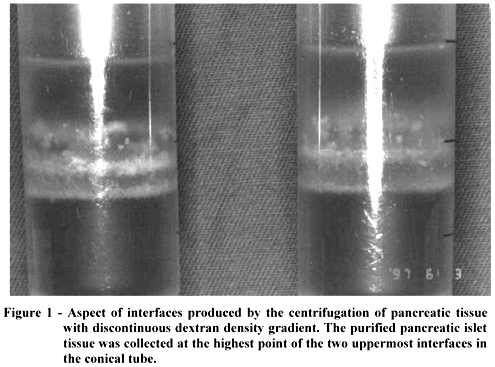The prospects for allotransplantation of pancreatic islets in man depend on the development of methods that provide sufficient quantities of pancreatic islets from a single donor, which are capable, when transplanted, of achieve the normalization of carbohydrate metabolism. Objective: Evaluate the efficacy of the isolation of Langerhans islets from dogs, by means of mechanical-enzymatic separation technique with stationary digestion using collagenase, and purification with a discontinuous dextran density gradient. Methods: The counting of islet numbers and evaluation of their sizes was accomplished by staining with diphenylthiocarbazone and using stereoscopic microscopes equipped with eyepiece reticule for the measurement of average diameters of stained islets. Results: The results disclosed that the average number of islets isolated was 81032.20 ± 24736.79 and the average number of islets isolated per kg of body weight was 6938.70 ± 1392.43. The average number of islets isolated per kg of body weight showed significant correlation with body weight and weight of the pancreas resected. Conclusion: The number of islets isolated, of a single donor, by mechanical-enzymatic separation, stationary collagenase digestion and discontinuous dextran density gradient purification can be sufficient to success of pancreatic islets transplant in dogs.
Islets of Langerhans; Transplantation; Diabetes Mellitus; Diabetes Mellitus, Experimental



